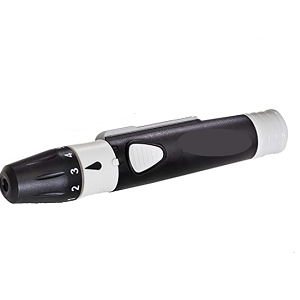
How do you use a lancet step by step?
How do I use the lancets?
Twist and pull the long piece of safety plastic off the end of the lancet. Then, place the lancet between your index and middle finger (like holding a syringe). Place and hold onto the finger you wish to draw blood from and press down on the large yellow button until you hear a click.


Twist and pull the long piece of safety plastic off the end of the lancet. Then, hold lancet between two fingers. Place against the finger you wish to draw blood from and press down until you hear a click.


Please Note – Under no circumstances should you use materials other than the lancets included in your test kit.
Demonstration Videos
Guidelines
How To Use A Disposable Lancet
- A disposable lancet is also frequently referred to as a single-use lancet. When learning how to use a disposable lancet, remember that it is intended to be used once and then promptly thrown away.
- You can use disposable lancets with a lancing device or alone. When used correctly, they can successfully obtain a capillary blood sample to monitor your blood sugar levels adequately. On rare occasions, individuals might also use lancing devices to draw blood effectively for some other necessary testing.
- You will find that lancets all share the following characteristics no matter what brand you choose:
- Tamper-resistant firm safety seal or a mechanism
- Needles come in various gauges
- Ultrafine tri bevel tip
- Steps to Use a Disposable Lancet To Draw Blood
- Instructions on how to use a disposable lancet:
- Wash your hands thoroughly with soap and water
- Dry your hands
- Swab your fingertip with an alcohol swab (many people forego this step because they feel it makes the blood collection process sting more)
- Break the safety seal on the lancet and read the included directions
- Select the fingertip where you will be obtaining the blood to put on the test strip
- Inspect your finger – it is best to aim slightly off the center of the fingertip and not the bullseye
- Insert the lancet into the lancing device (if you are using a lancing device) via the lancing device’s unique directions typically; this entails removing the cover on the lancing device and inserting the lancet. At that point, you will determine the depth on the device, and then you can effectively place the lancing device against your fingertip to launch the lancet using the device’s tailored instructions.
- If you are using a disposable lancet that requires no lancet device such as the easy-to-use lancets, then you can skip step six.
- With a lancet, you twist off the lid of the lancet for fast use without a lancing device.
- Apply pressure against your fingertip when using the lancet, and the device will automatically activate against your finger.
- Place a drop or two of blood on one of the test strips to check your blood glucose
- Wipe away any excess blood from your fingertip
- Dispose of the lancet immediately after use. If you used a traditional lancet device, then eject the lancet to dispose of it and recap the device for future use.
Tips to Reduce Fingertip Pain When Using a Disposable Lancet
- A properly engineered lancet causes less pain when used properly, although some people are more sensitive to the prick of the needle then others. However, there are steps that you can take to reduce the fingertip pain when using a disposable lancet for a finger stick.
- As mentioned above, in the steps on how to use a disposable lancet, test on the side of your fingertip and not directly in the center.
- Warm-up your hands prior to pricking your fingertip by rubbing them together rapidly and massaging to improve circulation.
- Do not press the lancet needle too hard into your fingertip.
- Avoid always using the index finger or thumb because those are the fingers you frequently use in your day-to-day life.
- Alternate fingers during each test, so you never use the same finger in a row when testing.
- Always use a disposable lancet to obtain blood for glucose monitoring – never reuse lancets.
Additional Information
OneTouch Verio Flex® – Removing the Used Lancet
Products
OneTouch Verio Flex® meter
Removing The Used Lancet:
- Note:This lancing device has an ejection feature, so you do not have to pull out the used lancet.
- Remove the lancing device cap.
- Removethe cap by rotating it and then pulling it straight off the device.
- Cover the exposed lancet tip.
- Before removing the lancet,place the lancet protective cover on a hard surface then push the lancet tip into the flat side of the disk.
- Eject the lancet.
- Holdingthe lancing device directed downwards, push the slider forward until the lancet comes out of the lancing device. If the lancet fails to eject properly, cock the device then push the slider control forward until the lancet comes out.
- Replace the lancing device cap.
- Placethe cap back onto the device; turn the cap or push the cap straight in to secure it.
- Ensure the cap is aligned as shown in the image.
- It is important to use a new lancet each time you obtain a blood sample. Do Notleave a lancet in the lancing device. This will help prevent infection and sore fingertips.
Disposing Of The Used Lancet And Test Strip:
- Discard the used lancet carefully after each use to avoid unintended lancet stick injuries. Used lancets and test strips may be considered biohazardous waste in your area. Be sure to follow your healthcare professional’s recommendations or local regulations for proper disposal.
- Washhands thoroughly with soap and water after handling the meter, test strips, lancing device and cap.
Reference Links
- OneTouch Verio Flex® – Product Guide
- OneTouch Verio® Test Strips – General Information
- OneTouch Verio Flex® – Sampling Blood from the Fingertip
- OneTouch Verio Flex® – Getting to Know Your OneTouch® Delica® Plus Lancing Device
- OneTouch Verio Flex® – Preparing Your OneTouch® Delica® Plus Lancing Device
- OneTouch Verio Flex® – Caring for Your System
Related Devices
How To Use A Disposable Lancet Instructions
How do you use a lancet step by step? Twist Read more...
InPen – Insulin Pen & App
InPen Insulin Monitor Smart diabetes technology. InPen is the Read more...
Omnipod Dash Insulin Management
Omnipod DASH Insulin Management The Omnipod DASH™ Insulin Management Read more...
FreeStyle Libre 14 day sensor (CGM)
FreeStyle Libre 14 day sensor Blood Glucose Read more...
FreeStyle Precision Neo meter
FreeStyle Precision Neo The FreeStyle Precision Neo Blood Glucose Read more...
FreeStyle Freedom Lite meter
FreeStyle Freedom Lite Blood Glucose Monitoring System Self-testing is Read more...

